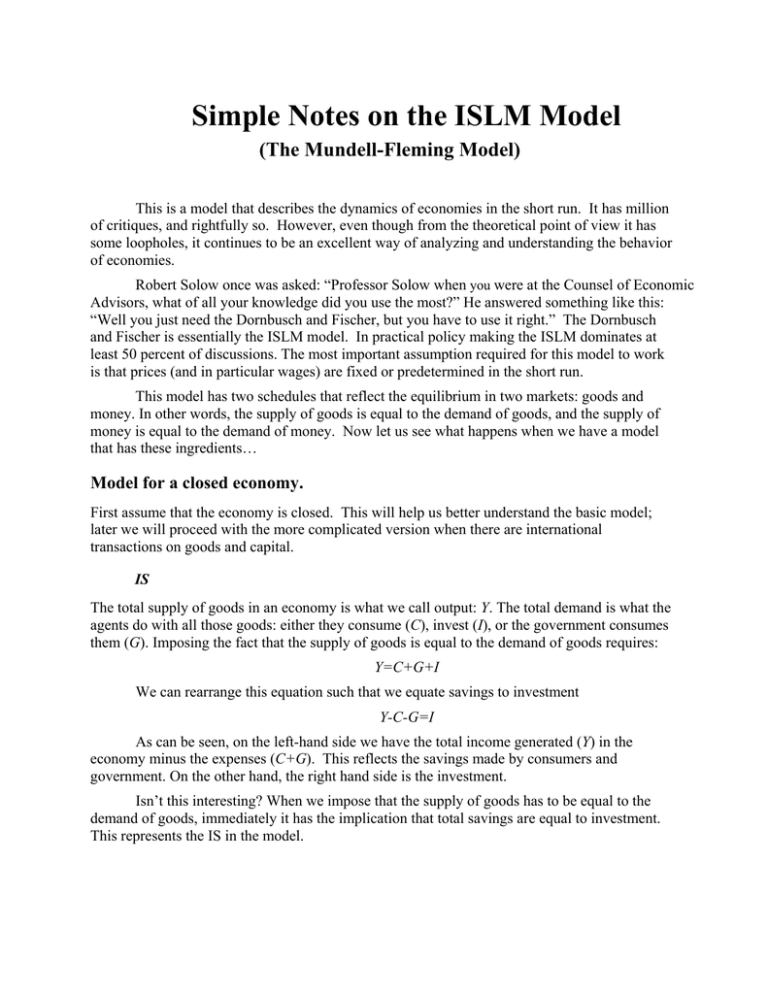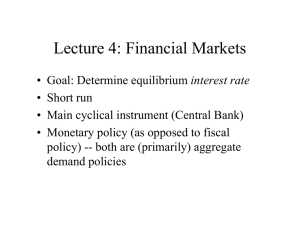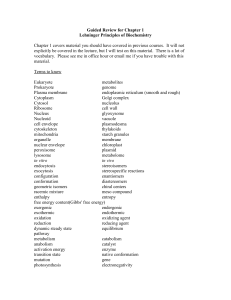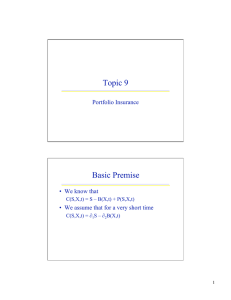Simple Notes on the ISLM Model (The Mundell-Fleming Model)
advertisement

Simple Notes on the ISLM Model (The Mundell-Fleming Model) This is a model that describes the dynamics of economies in the short run. It has million of critiques, and rightfully so. However, even though from the theoretical point of view it has some loopholes, it continues to be an excellent way of analyzing and understanding the behavior of economies. Robert Solow once was asked: “Professor Solow when you were at the Counsel of Economic Advisors, what of all your knowledge did you use the most?” He answered something like this: “Well you just need the Dornbusch and Fischer, but you have to use it right.” The Dornbusch and Fischer is essentially the ISLM model. In practical policy making the ISLM dominates at least 50 percent of discussions. The most important assumption required for this model to work is that prices (and in particular wages) are fixed or predetermined in the short run. This model has two schedules that reflect the equilibrium in two markets: goods and money. In other words, the supply of goods is equal to the demand of goods, and the supply of money is equal to the demand of money. Now let us see what happens when we have a model that has these ingredients… Model for a closed economy. First assume that the economy is closed. This will help us better understand the basic model; later we will proceed with the more complicated version when there are international transactions on goods and capital. IS The total supply of goods in an economy is what we call output: Y. The total demand is what the agents do with all those goods: either they consume (C), invest (I), or the government consumes them (G). Imposing the fact that the supply of goods is equal to the demand of goods requires: Y=C+G+I We can rearrange this equation such that we equate savings to investment Y-C-G=I As can be seen, on the left-hand side we have the total income generated (Y) in the economy minus the expenses (C+G). This reflects the savings made by consumers and government. On the other hand, the right hand side is the investment. Isn’t this interesting? When we impose that the supply of goods has to be equal to the demand of goods, immediately it has the implication that total savings are equal to investment. This represents the IS in the model. Savings behavior We are interested in understanding what is the savings behavior when fiscal and monetary policy are implemented. This is what we are going to do here. We know that part of consumers' income is taxed. For simplicity assume the tax rate is fixed and given by t. The savings can be written as follows: S=(1-t)Y-C + tY-G What this equation implies is that total savings in the economy are equal to consumers' savings (the first two terms) plus the government’s savings (the negative of the fiscal deficit). From the microeconomic literature we know that consumers will consume depending on their disposable income and the interest rate. The microeconomic literature does not have a precise answer of what is the effect of interest rates on current consumption. There are two effects that go in opposite directions: the income and substitution effect. We are not interested in solving this problem at the macro level, and we will make the assumption that consumption is unaffected by the interest rate1. When this is the case, we can write consumption as follows: C=c(1-t)Y Where c (less than one) is the marginal propensity to consume for each additional unit of disposable income ((1-t)Y). S=(1-c)(1-t)Y+tY-G Note that if Y or t increases, savings increase. If G or c increases, savings decrease. Investment Let’s now concentrate on investment. It is easy to argue that investments in the economy are inversely proportional to the interest rate. The nominal interest rate is some measure of the cost of capital, and according to our macro theories, we should observe less accumulation of capital. For simplicity we will write the following: I=I(i) Where i is the interest rate. Equilibrium Assume that point A is a point in which there is equilibrium: Therefore savings are equal to investment. Assume that maintaining the same interest rate, we increase output in the economy. According to our behavioral equations investment remains the same, but savings increase. Thus this is a point in which savings is larger than investment. Now, assume we return to point A and maintaining the same output we reduce the interest rate. As we argue before, there is no change in consumption (this is obviously a simplification) and therefore on total savings. However, there is an increase in investment. Thus this is a point in which savings are smaller than investment. 1 In fact this is the case when the elasticity of substitution is equal to one. Going from the point in which savings is larger than investment to the point in which savings is smaller than investment we have to cross a point in which savings is equal to investment. What this implies is that all the points in which savings are equal to the investment are represented by a downward sloping curve. The IS. i A S>I S<I IS Y The intuition is quite easy. If we are at a point in which savings are equal to investment, a reduction in the interest rate will produce an increase in investment that has to be compensated by an increase in savings. The only way to accomplish this is to increase output. What is the effect of changes in savings rates (1-c) and fiscal policy? Let’s analyze only one of them. Assume we are at point A. If there is an increase in government expenditure (or a reduction in taxes, or a reduction in the savings rate) total savings in the economy are going to go down. Therefore, at the same interest rate and the same output, point A is no longer an equilibrium. i A Y In order to return to equilibrium we have to reduce investment or compensate the loss in savings. Thus, either output goes up, or the interest goes up, or both. This means that the IS schedule has shifted upward. LM Now let’s concentrate on the other market: the equilibrium on the monetary side. Assume there are only two assets: currency and government bonds. Money does not earn interest, but the government bonds carry the market interest rate: i. Currency, however, has a role in the economy given that it allows people to perform transactions that otherwise could have not been implemented (pay cabs, buy coffee, etc.).2 We assume the supply of currency is determined by the central bank: M. The demand for currency is then determined by what the consumers decide to do with their holdings. We assume consumers solve a portfolio problem and allocate part of their wealth (which is proportional to income: Y) as currency and the rest is saved in bonds. We should expect two things: first, when the interest rate increases a smaller proportion is held in currency. The intuition is that the opportunity cost of holding cash increases and individuals should shift part of their portfolio toward bonds. Second, when wealth increases individuals should hold more cash. In other words, the shares assigned to money might change with increases in wealth but not in such a way that will overcome the initial impact. In other words, we should expect that an increase in the interest rate reduces the demand for money, and that an increase in output will increase the demand for money. You can think of this demand as a transactional demand for money. The more transactions there are, the larger the cash required to perform them. Thus, Md=Md(i,Y)=x(i)Y Where the functions (Md and x) are decreasing in the interest rate, but Md is increasing in output. Let's draw the curve then. Assume point A is a place in which the demand for money equals the supply. Assume there is an increase in the interest rate maintaining output constant. We have argued that the demand for money will fall, because the supply is determined exogenously by the central bank, this is a situation in which the demand for money is smaller than the supply. Assume that now we return to point A and here we increase output only. Income goes up and the amount required in cash increases. The demand for money is larger than the supply. Moving from this point to the previous one we will have to cross zero and this implies that the LM is an increasing schedule. i LM Md<M A Md>M Y Let's see what happens when there is an expansion in the money supply. Assume that we are at point A, where there is equilibrium in the money market. If the central bank increases the money supply, suddenly A is a place in which the demand for money is smaller than the money 2 This is a very prolific area of study in macro that we have been unable to answer satisfactory. In economics we do not have very good reasons why money exists. We have some ideas that indeed justify its existence in the past, but it is hard nowadays. In any case, you should feel good if for you is hard to make sense why individuals hold currency. You are definitely in incredibly good company. supply. Therefore, for the same interest rate and output, point A is no longer an equilibrium. To return to equilibrium, then, it is necessary that the demand for money has to increase. This is achieved by increasing output, reducing interest rates, or both. i A Y Usually the intuition of how the LM works is not very clear. Do not worry! Do not panic! For sure I can tell you that you are in good company. So, le’ts do it again in a simplified portfolio model. Assume consumers have some wealth (W) that they allocate between two assets: money (issued by the central bank) and government bonds (issued by the bad guys). The consumer has to decide how much should be allocated to bonds and how much to money. Money produces utility to consumers given that it provides some services. Bonds, on the other hand, pay an interest rate. We are not terribly interested in the particular portfolio problem; however, it should be intuitive that the demand for bonds is a decreasing function of its price. In other words, demand for bonds is an increasing function of the interest rate. Assume the supply of government bonds is fixed then the equilibrium price of the bonds is given by: Pb Db Note that if the supply of bonds increases the equilibrium price has to fall, which means that the implicit yield on the bond increases. This makes sense given that an increase in the supply of bonds has to convince consumers to hold more bonds and the same amount of cash. To do so, I have to increase the return on the bonds. What is even more interesting in this simple framework is how the central bank policy works. In practice the central bank is another agent that demands government bonds; the difference is that it pays “currency” to exchange the bonds they are buying or selling. Hence, when the central bank decides to BUY bonds it will pay with CASH. Note that the increase in the demand for bonds increases its price – which implies that the interest rate goes down. The central bank now has more bonds, which means that consumers have less bonds and more cash. In this transaction, the share of consumers’ wealth invested in bonds has come down, and the cash holdings have increased. This situation is called an “expansionary monetary policy.” The central bank increased the money supply (cash in the hands of the consumers) and the outcome is that the interest rate has come down. This is the day to day operation of a central bank; they are in the business of buying and selling government bonds to satisfy the money demands of consumers. You might ask “but that is not the way the US central bank works.” That’s right. There are several ways in which monetary policy is implemented. Some of them control the money supply and the price is decided by the market; others decide the interest rate and the money supply is decided by the market (so the central bank decides the price at which to buy or sell the government bonds and buys or sells all the quantities the market decides); others have more complex objectives such as the exchange rate, etc. We will come back to these issues later. For the moment, this should be enough to understand how the ISLM works. Pb Db’ Db IS-LM: The model. Let’s now put both schedules together. As any respectable model in economics, there is a downward and an upward schedule. And as it should be expected, they intersect once, and we tend to like this point. This model indicates what is the unique combination of output and interest rates that is consistent with both equilibrium in the goods market and equilibrium in the money market. In this model, I have depicted how the schedules move when there is a change in fiscal or monetary variables. The arrows reflect how the curves move when there is an increase in the variable highlighted. In summary, an expansionary monetary policy reduces the interest rate and increases output in the short run. On the other hand, an expansionary fiscal policy (either an increase in expenditures or a tax-cut) increases the interest rate and output. Finally, a decrease in the marginal propensity to save (an increase in c) increases the interest rate and output. A very important discussion in the literature was (this is 20 years ago) the slope of the curves. In particular, a very important discussion was whether or not some of these curves are totally vertical or horizontal. The interesting thing is that each of these cases has a particular name and is kind of a particular "sickness" that an economy suffers. We will return to these points later in the course LM i M G,c t IS Y Finally, note that a particular implication previously highlighted sounds paradoxically. How can a reduction in the savings rate imply more output? See the notes called “The Fiscal Multiplier Effect” to understand why this is indeed the case.







